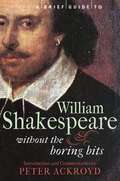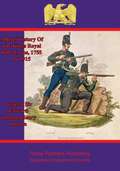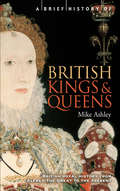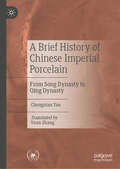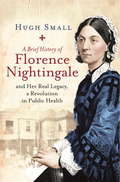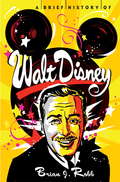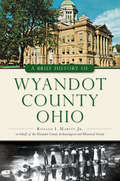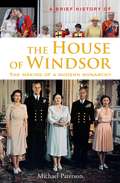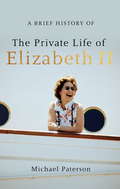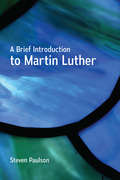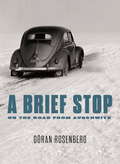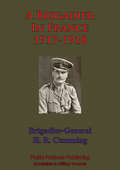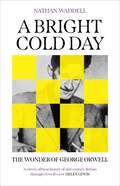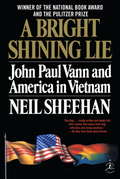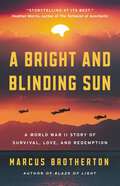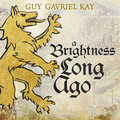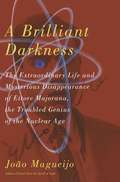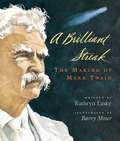- Table View
- List View
A Brief Guide to William Shakespeare (Brief Histories)
by Peter AckroydAn accessible and entertaining journey through the life, times, and work of the Bard - Enigma. Master of language. The greatest comedian in history? The most famous writer in the world. But isn't he a little bit boring? This is an essential guide for anyone who has previously avoided the Bard, and is the perfect introduction for first time students or seasoned theatre lovers. The book contains a full commentary of all the plays by bestselling and reknowned writer Peter Ackroyd as well as full descriptions of the cast and the drama; not forgetting the best speeches, and the wit and wisdom from across the works. There is also an opportunity to explore the poems and a complete set of sonnets, as well as an investigation of who the dark lady might have been.Contains:The complete sonnets; the greatest speeches; the best lines.Perfect for students struggling through their first play or for theatre lovers anywhere.Entertaining, accessible, Shakespeare without the boring bits.
A Brief History Of The Kings Royal Rifle Corps, 1755 To 1915
by General Sir Edward Thomas Henry HuttonThe Kings Royal Rifle Corps, or the 2nd Battalion the Royal Green Jackets as they are now known, had a long and proud fighting tradition that they would exchange with no other regiment in the British Army. Originally raised from American colonists in 1756, their skill in fighting the French and their native American allies in the woods in the north of the nascent America was legendary; the regiment was honoured for its distinguished service with the motto "Swift and Bold" by no less a figure as General Wolfe in the Quebec campaign. During the Napoleonic Wars, companies of the 5th Battalion were attached to the divisions of Wellington's army to provide them with tough, resilient experienced skirmishers. After many significant deployments to overseas theatres during the 1800's, the regiment was hugely expanded for service in the First World War during which the men of the KRRC added much lustre to their reputation and no fewer than seven V.C.s.Lt.-General Sir Edward Hutton was a distinguished officer of the British army, aide-de-camp to Queen Victoria and pioneered the use of mounted infantry in the British Army. He was also the first commander of the Australian Army. He wrote this short history of his old regiment in retirement during the early stages of the First World War.Author -- Lt.-General Sir Edward Thomas Henry Hutton 1848-1923Text taken, whole and complete, from the edition published in 1917, Winchester, by Warren and SonOriginal Page Count - 84 pages.Illustrations -- 4 maps and plans.
A Brief History of British Kings & Queens (Brief History)
by Mike AshleyHere is the whole of recorded British royal history, from the legendary King Alfred the Great onwards, including the monarchies of England, Scotland, Wales and the United Kingdom for over a thousand years. <P><P>Fascinating portraits are expertly woven into a history of division and eventual union of the British Isles - even royals we think most familiar are revealed in a new and sometimes surprising light. This revised and shortened edition of The Mammoth Book of British Kings & Queens includes biographies of the royals of recorded British history, plus an overview of the semi-legendary figures of pre-history and the Dark Ages - an accessible source for students and general readers.
A Brief History of Chinese Imperial Porcelain: From Song Dynasty to Qing Dynasty
by Chongnian YanThis book provides a unique history of the Porcelain Road against the backdrop of Chinese and Western cultural exchanges. Written by one of China’s most influential scholars, it introduces the history of Chinese Porcelain, especially the history of the imperial porcelain kiln, taking the most representative porcelain of each period as examples, and examining relevant historical background. Studying artifacts from well-known collections such as the Palace Museum, Taipei Palace Museum, Shenyang Palace Museum, Nanjing Museum, this text offers a unique discussion of China’s porcelain culture and history, and will be of relevance to all those interested in one of the key aspects of Chinese culture and cultural exchanges between East and West.
A Brief History of Florence Nightingale: and Her Real Legacy, a Revolution in Public Health
by Hugh SmallFlorence Nightingale (1820-1910) is best known as a reformer of hospital nursing during and after the Crimean War, but many feel that her nursing reputation has been overstated. A Brief History of Florence Nightingale tells the story of the sanitary disaster in her wartime hospital and why the government covered it up against her wishes. After the war she worked to put the lessons of the tragedy to good use to reduce the very high mortality from epidemic disease in the civilian population at home. She did this by persuading Parliament in 1872 to pass laws which required landlords to improve sanitation in working-class homes, and to give local authorities rather than central government the power to enforce the laws. Life expectancy increased dramatically as a result, and it was this peacetime civilian public health reform rather than her wartime hospital nursing record that established Nightingale's reputation in her lifetime. After her death the wartime image became popular again as a means of recruiting hospital nurses and her other achievements were almost forgotten. Today, with nursing's new emphasis on 'primary' care and prevention outside hospitals, Nightingale's focus on public health achievements makes her an increasingly relevant figure.
A Brief History of Florence Nightingale: and Her Real Legacy, a Revolution in Public Health (Brief Histories)
by Mr Hugh SmallPraise for Small's earlier work on Nightingale: 'Hugh Small, in a masterly piece of historical detective work, convincingly demonstrates what all previous historians and biographers have missed . . . This is a compelling psychological portrait of a very eminent (and complex) Victorian.' James Le Fanu, Daily TelegraphFlorence Nightingale (1820-1910) is best known as a reformer of hospital nursing during and after the Crimean War, but many feel that her nursing reputation has been overstated. A Brief History of Florence Nightingale tells the story of the sanitary disaster in her wartime hospital and why the government covered it up against her wishes. After the war she worked to put the lessons of the tragedy to good use to reduce the very high mortality from epidemic disease in the civilian population at home. She did this by persuading Parliament in 1872 to pass laws which required landlords to improve sanitation in working-class homes, and to give local authorities rather than central government the power to enforce the laws. Life expectancy increased dramatically as a result, and it was this peacetime civilian public health reform rather than her wartime hospital nursing record that established Nightingale's reputation in her lifetime. After her death the wartime image became popular again as a means of recruiting hospital nurses and her other achievements were almost forgotten. Today, with nursing's new emphasis on 'primary' care and prevention outside hospitals, Nightingale's focus on public health achievements makes her an increasingly relevant figure.
A Brief History of Oversharing: One Ginger's Anthology of Humiliation
by Shawn HitchinsFrom the author of The Light Streamed Beneath, a collection of hilarious and heartfelt autobiographical essays about accepting our quirks & flaws. Comedian Shawn Hitchins explores his irreverent nature in this debut collection of essays. Hitchins doesn&’t shy away from his failures or celebrate his mild successes—he sacrifices them for an audience&’s amusement. He roasts his younger self, the effeminate ginger-haired kid with a competitive streak. The ups and downs of being a sperm donor to a lesbian couple. Then the fiery redhead professes his love for actress Shelley Long, declares his hatred of musical theatre, and recounts a summer spent in Provincetown working as a drag queen. Nothing is sacred. His first major break-up, how his mother plotted the murder of the family cat, his difficult relationship with his father, becoming an unintentional spokesperson for all redheads, and ̶m̶a̶n̶d̶y̶ ̶m̶o̶o̶r̶e̶ many more. Blunt, awkward, emotional, ribald, this anthology of humiliation culminates in a greater understanding of love, work, and family. Like the final scene in a Murder She Wrote episode, A Brief History of Oversharing promises everyone the a-ha! moment Oprah tells us to experience. Paired with bourbon, Scottish wool, and Humpty Dumpty Party Mix, this journey is best heard through a lens of schadenfreude. Praise for A Brief History of Oversharing&“I am so glad I am not Shawn Hitchins, but I sure wish I could write like him. A Brief History of Oversharing is hilarious and heartwarming. Reading it is like sharing a warm bath with the man himself. At least I hope it&’s the bath that&’s warm.&” —Michael Urie, actor (The Good Wife, Modern Family, Ugly Betty)&“Hitchins&’s mix of raw emotion and salty hilarity works beautifully. . . . Hitchins has a gift for telling outwardly repulsive stories in a way that actually draws people in. He doesn&’t gloss over hard times, but he does counterbalance them with a self-deprecating, snarky humor that trades tears for laughter. He&’s not kidding when he says he&’s oversharing, but somehow he makes the mix of raw emotion and salty hilarity work.&” —Foreword Reviews
A Brief History of Walt Disney (Brief Histories)
by Brian RobbBoth a fascinating account of Walt Disney’s own significant artistic creations, from the iconic Mickey Mouse to the groundbreaking Snow White in 1937, and an insightful history of the hugely successful entertainment behemoth he created, from Dumbo to Pixar’s Toy Story, as well as the hugely popular theme parks. But Disney’s dark side is also explored: his disputed parentage; industrial disputes; his work for the FBI; and his anti-Communist and allegedly racist and antisemitic views.The company Disney built is today stronger than ever, encompassing not only the ongoing legacy of Disney animation, but also acting as the guardian of other well-loved creative endeavours, such as Pixar, The Muppets, Marvel Comics and now Star Wars.Sections include ‘Before Mickey: The Road to the Mouse House’, covering from 1901 to 1945 – the creation of Mickey Mouse, the creation of the world’s first full-length animated feature film, the Golden Age of animation and Disney’s help for the American war effort, despite labour disputes; ‘Disney Studios: The Disney Genius’ – difficult times, theme parks and television, live-action movies, including Mary Poppins; ‘Animation’s Second Coming’, from the Lady and the Tramp to The Sword in the Stone, and Walt Disney’s death; ‘After Walt: The Disney Legacy’ – family attempts to keep the studio afloat, decline and the loss of lustre in the 1970s and 1980s; ‘Disney Resurgent’ – a triumphant rebirth under new management with Who Framed Roger Rabbit? The Lion King and other blockbuster hits; ‘From Eisner to Iger’ – the corporate battle for the soul of Disney; ‘Disney Goes Digital’ – from Pixar to Star Wars, via Marvel Comics and The Muppets, Disney buyy up other studios, themselves often enough inspired by the original.
A Brief History of Wyandot County, Ohio (Brief History)
by Ronald I. Marvin Jr. Wyandot County Archaeological and Historical SocietyOnce home to the powerful Wyandotte Nation, Wyandot County emerged from lands surrounding the Grand Reserve. The landscape has evolved dramatically, from the backbreaking work of draining marshland to the creation of solar farms centuries later. The Mission Church, Indian Mill and Colonel Crawford Monument link the county to its rich heritage, and the Lincoln Highway connects it with the rest of the nation. The county has played host to General William Harrison, President Rutherford Hayes, Charles Dickens, Medal of Honor recipient Cyrus Sears and Neil Armstrong. Author Ronald I. Marvin Jr. explores several thousand years of Wyandot history from its earliest inhabitants to the set of the Shawshank Redemption.
A Brief History of the House of Windsor: The Making Of A Modern Monarchy
by Michael PatersonThe British monarchy may be over a thousand years old, but the House of Windsor dates only from 1917, when, in the middle of the First World War that was to see the demise of the major thrones of continental Europe, it rebranded itself from the distinctly Germanic Saxe-Coburg-Gotha to the homely and familiar Windsor. By redefining its loyalties to identify with its people and country rather than the princes, kings and emperors of Europe to whom it was related by birth and marriage, it set the monarchy on the path of adaptation, making itself relevant and allowing it to survive. Since then, the fine line trodden by the House of Windsor between ancient and modern, grandeur and thrift, splendour and informality, remoteness and accessibility, and influence and neutrality has left it more secure and its appeal more universal today than ever.
A Brief History of the House of Windsor: The Making of a Modern Monarchy (Brief Histories)
by Michael PatersonThe British monarchy may be over a thousand years old, but the House of Windsor dates only from 1917, when, in the middle of the First World War that was to see the demise of the major thrones of continental Europe, it rebranded itself from the distinctly Germanic Saxe-Coburg-Gotha to the homely and familiar Windsor. By redefining its loyalties to identify with its people and country rather than the princes, kings and emperors of Europe to whom it was related by birth and marriage, it set the monarchy on the path of adaptation, making itself relevant and allowing it to survive. Since then, the fine line trodden by the House of Windsor between ancient and modern, grandeur and thrift, splendour and informality, remoteness and accessibility, and influence and neutrality has left it more secure and its appeal more universal today than ever.
A Brief History of the Private Life of Elizabeth II
by Michael PatersonElizabeth II is within a few years of becoming the longest-reigning British monarch. A personally quiet, modest and dutiful person, she is far better-informed about the lives of her subjects than they often realize. She has known every Prime Minister since Winston Churchill and every American President since Eisenhower.Yet what of the woman behind the crown?The book seeks to take a new look at this exhaustively-documented life and show how Queen Elizabeth became the person she is. Who, and what, have been the greatest influences upon her? What are her likes and dislikes? What are her hobbies? Who are her friends? What does she feel about the demands of duty and protocol? Is she really enjoying herself when she smiles during official events? How differently does she behave when out of the public eye? Examining the places in which she grew up or has lived, the training she received and her attitudes to significant events in national life, it presents a fresh view of one of recent history's most important figures.
A Brief History of the Private Life of Elizabeth II (Brief Histories)
by Michael PatersonElizabeth II is the longest-reigning British monarch. A personally quiet, modest and dutiful person, she is far better-informed about the lives of her subjects than they often realize. She has known every Prime Minister since Winston Churchill and every American President since Eisenhower. Yet what of the woman behind the crown?This book seeks to take a new look at this exhaustively-documented life and show how Queen Elizabeth became the person she is. Who, and what, have been the greatest influences upon her? What are her likes and dislikes? What are her hobbies? Who are her friends? What does she feel about the demands of duty and protocol? Is she really enjoying herself when she smiles during official events? How differently does she behave when out of the public eye? Examining the places in which she grew up or has lived, the training she received and her attitudes to significant events in national life, it presents a fresh view of one of recent history's most important figures.In recent years, Queen Elizabeth has become the longest-reigning monarch in our history and has cut back on commitments. Nevertheless she is still very active and has made some wise decisions about who takes over a number of her duties.
A Brief Introduction to John Calvin
by Christopher ElwoodHonoring the 500th anniversary of the Reformation, Christopher Elwood offers an insightful and accessible overview of John Calvin's theological ideas within their historical context. A Brief Introduction to John Calvin discusses the trials and tribulations Calvin encountered as he ministered and taught in Geneva, paying special attention to the theological controversies associated with the Trinity and predestination. In this concise introduction, Elwood explores the development of Calvinism and its influence in today's world.
A Brief Introduction to Martin Luther
by Steven PaulsonIn the sixteenth century, Martin Luther started a reformation movement that revolutionized Europe and the history of the Christian faith. His far-reaching reforms of theological understanding and church practices dramatically changed both church and society in Europe and beyond. In honor of the 500th anniversary of the Reformation, Steven Paulson provides an engaging, concise introduction to Martin Luther's life and the major themes in his theology.
A Brief Stop On the Road From Auschwitz
by Sarah Death Goran RosenbergThis shattering memoir by a journalist about his father's attempt to survive the aftermath of Auschwitz in a small industrial town in Sweden won the prestigious August PrizeOn August 2, 1947 a young man gets off a train in a small Swedish town to begin his life anew. Having endured the ghetto of Lodz, the death camp at Auschwitz-Birkenau, the slave camps and transports during the final months of Nazi Germany, his final challenge is to survive the survival. In this intelligent and deeply moving book, Göran Rosenberg returns to his own childhood to tell the story of his father: walking at his side, holding his hand, trying to get close to him. It is also the story of the chasm between the world of the child, permeated by the optimism, progress, and collective oblivion of postwar Sweden, and the world of the father, darkened by the long shadows of the past.
A Brigadier In France – 1917-1918
by Brigadier Hanway Robert Cumming"Great War memoirs of an officer who served on the Western front as a battalion commander (2 DLI) then as commander 91st Brigade, 7th Division. He was dismissed during the Battle of Bullecourt in May 1917 but came back in May 1918 as commander 110th Brigade. Murdered in Ireland in March 1921 while commanding the Kerry BrigadeHanway Robert Cumming was commissioned into the Durham Light Infantry (DLI) in 1889 and saw active service during the South African War. He was in a staff appointment in India in August 1914 and did not arrive in France till June 1915 where he again held staff appointments until August 1916 when he took command of 2nd DLI. In November 1916 he was appointed to command of the 91st Brigade, 7th Division, a post he held till May 1917 when, during the Battle of Bullecourt he was summarily dismissed by the divisional commander (Shoubridge) and went home on leave, under protest as he describes in the book (less than a month later he was awarded the DSO in the 1917 Birthday Honours!). From August 1917 to the following February he commanded the MG Corps Training Centre at Grantham and then, in March 1918 he went back to France to command the 110th Brigade, 21st Division where he stayed to the end of the war. After the war, while commanding the Kerry Brigade in Ireland he was murdered, on 6th March 1921...The greater part of the book deals with his command of the 110th Brigade which he took over less than a week before the German Spring offensive, which is dealt with in detail, as is the May offensive in Champagne in which 21st Division was one of the five British divisions fighting under French command, and then the final allied counter-offensive. In all this is an interesting picture of the life of a brigade commander on the Western front. He tells his story in the third person, referring to himself throughout as the brigadier."--N&M Press Ed.
A Bright Cold Day: The Wonder of George Orwell
by Nathan WaddellA pioneering biography of George Orwell told through moments of everyday life 'A clever, offbeat history of mid-century Britain through George Orwell&’s eyes.' Helen Lewis When we think about Orwell, we imagine an angular, moustachioed sceptic crouched over a typewriter, who – between puffs on his cigarette – composes effortless streams of prose, unadorned but explosive. We see a man with &‘Important Things to Say&’ about: the slow creep of authoritarianism; the consequences of all-seeing tech; the fragility of truth. Much less often do we see him as a person caught up in the business of everyday life. And yet Orwell&’s work thrums with the quotidian: the smell of boiled cabbage, the chill of an unheated flat in early spring, the rumbling of old pipes. A Bright Cold Day reveals how the principles that govern us begin in the mundane. From waking and showering to breakfast, work, lunch, the pub, sleep and dreaming, Orwell was never dulled to the routines of living. And in the details of the day, we can understand how power, money, freedom and choice play out, not just for Orwell&’s literary characters, but for us all. *** 'An astute and intimate portrait of George Orwell.' Dorian Lynskey, author of The Ministry of Truth 'Beautifully written... urgent and compelling.' Emma Smith, author of Portable Magic
A Bright Shining Lie: John Paul Vann And America In Vietnam (Picador Bks.)
by Neil SheehanOutspoken and fearless, John Paul Vann arrived in Vietnam in 1962, full of confidence in America's might and right to prevail. A Bright Shining Lie reveals the truth about the war in Vietnam as it unfolded before Vann's eyes: the arrogance and professional corruption of the U.S. military system of the 1960s, the incompetence and venality of the South Vietnamese army, the nightmare of death and destruction that began with the arrival of the American forces. Witnessing the arrogance and self-deception firsthand, Vann put his life and career on the line in an attempt to convince his superiors that the war should be fought another way. But by the time he died in 1972, Vann had embraced the follies he once decried. He went to his grave believing that the war had been won.<P><P> A haunting and critically acclaimed masterpiece, A Bright Shining Lie is a timeless account of the American experience in Vietnam–a work that is epic in scope, piercing in detail, and told with the keen understanding of a journalist who was actually there. Neil Sheehan' s classic serves as a stunning revelation for all who thought they understood the war.<P> Winner of the Pulitzer Prize.<P> Winner of the National Book Award
A Bright and Blinding Sun: A World War II Story of Survival, Love, and Redemption
by Marcus BrothertonFrom a New York Times bestselling author comes the incredible true story of an underage soldier's first love and loss on the battlefields of Bataan and Corregidor—perfect for fans of The Boy Who Followed His Father into Auschwitz and Unbroken. Joe Johnson Jr. ran away from home at the age of 12, hopping a freight train at the height of the Great Depression. He managed to talk his way into the U.S. Army two years later. Seeking freedom and adventure, he was sent to the Philippines. Adrift in spirit, Joe visited a teenage prostitute, and they became unlikely, smitten allies. Yet when the Japanese attacked on December 8, 1941, their hopes of being together had to wait. Joe and his fellow soldiers fought for four brutal months in Bataan and Corregidor, until they were forced to surrender. The boy endured years of horror as a prisoner of war, only dreaming about seeing again the girl he&’d come to love. This lyrically written and deeply encouraging saga will remind you that every life can be lifted, forgiveness is the patron of restoration, and redemption is available to all.
A Brightness Long Ago
by Guy Gavriel KayInternationally bestselling author Guy Gavriel Kay's latest work is set in a world evoking early Renaissance Italy, with an extraordinary cast of characters.In a chamber overlooking the nighttime waterways of a maritime city, a man looks back on his youth and the people who shaped his life. Danio Cerra's intelligence won him entry to a renowned school, though he was only the son of a tailor. He took service at the court of a ruling count - and soon learned why that man was known as The Beast.Danio's fate changed the moment he recognized Adria Ripoli as she entered the count's chambers one night - intending to kill. Born to power, Adria had chosen a life of danger - and freedom - instead.Other vivid figures share the story: a healer determined to defy her expected lot; a charming, frivolous son of immense wealth; a religious leader more decadent than devout; and, affecting these lives and many more, two mercenary commanders, whose rivalry puts a world in the balance. A Brightness Long Ago offers both compelling drama and deeply moving reflections on the nature of memory, the choices we make in life, and the role played by the turning of Fortune's wheel.(P)2019 Hodder & Stoughton LimitedPraise for Guy Gavriel KayPraise for Guy Gavriel Kay 'The greatest living author of epic fantasy' Brandon Sanderson 'Contemporary fiction's finest fantasist' Tor.com 'History and fantasy rarely come together as gracefully or readably as they do in the novels of Guy Gavriel Kay' Washington Post 'One of the (if not the) premiere fantasists of our time' The Financial Times 'Compulsively readable . . . Kay is a global phenomenon . . . a storyteller on the grandest scale' Time Magazine (Canada)(P) 2019 Hodder & Stoughton Ltd
A Brilliant Darkness: The Extraordinary Life and Mysterious Disappearance of Ettore Majorana, the Troubled Genius of the N
by João MagueijoOn the night of March 26, 1938, nuclear physicist Ettore Majorana boarded a ship, cash and passport in hand. He was never seen again. <P><P> In A Brilliant Darkness, theoretical physicist João Magueijo tells the story of Majorana and his research group, "the Via Panisperna Boys," who discovered atomic fission in 1934. As Majorana, the most brilliant of the group, began to realize the implications of what they had found, he became increasingly unstable. Did he commit suicide that night in Palermo? Was he kidnapped? Did he stage his own death? A Brilliant Darkness chronicles Majorana's invaluable contributions to science--including his major discovery, the Majorana neutrino--while revealing the truth behind his fascinating and tragic life.
A Brilliant Life: My Mother's Inspiring True Story of Surviving the Holocaust
by Rachelle UnreichThe powerful, true story of a Holocaust survivor told by her daughter—a tale that reminds us of the resilience of the soul and the ability of the heart to heal.As Mira is nearing the end of her life, her daughter Rachelle wants to find out how her mother had lived through four concentration camps, including Auschwitz, and a Death March. There was a mystery to her survival, it seemed—which perhaps had something to do with the strange things that always happened around her. And, incredibly, when giving testimony later in life, she says that it was during this time—despite witnessing the depths of man’s cruelty—that she learned about “the goodness of people.”Born in Czechoslovakia, Mira was only 12 years old when World War II broke out. At 88, living in Australia, she is diagnosed with cancer, and her journalist daughter decides to interview her to distract her from her illness. What Rachelle discovers about her mother helps her fit together the jigsaw pieces of her own life. A Brilliant Life portrays not only how remote a prospect it was to live through the Holocaust, but what it is like to be the child of a survivor. A story of love, loss, wonder and the deepest kind of faith, A Brilliant Life questions the role that fate, chance and destiny play in one's life. It is a tribute to family, a story of incredible resilience and a chronicle of the deep connection between mother and child that not even death can destroy.
A Brilliant Streak: The Making Of Mark Twain
by Kathryn Lasky Barry MoserIn this beautifully illustrated biography, Mark Twain's adventures as a young boy come to life. Before Samuel Clemens became a famous author, he enjoyed one of the longest childhoods in history. From playing hooky in Hannibal, Missouri, to piloting steamboats on the Mississippi River, Mark Twain's adventures as a youth influenced his entire life and figured prominently in his writing. Focusing on the first half of Clemens's life, this book will be enjoyed by longtime Twain devotees--and by those who seek a colorful introduction to the ever-popular author and his works.
